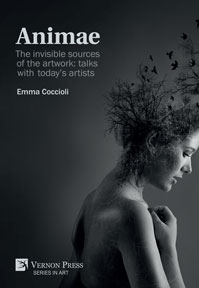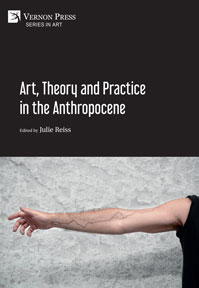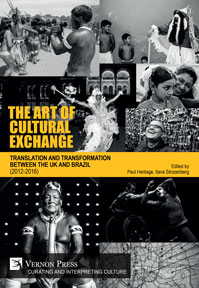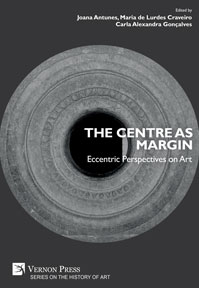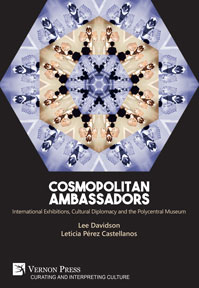International Opportunities in the Arts
Mary Sherman (Ed.)
by Antoine Abi Aad (Lebanese University), Doris Sommer (Harvard University), Claudia Lefko (The Iraqi Children's Art Exchange), Fiona Davies (University of Sydney), Ian J. Koebner (University of California, Davis), Scott M. Fishman (University of California, Davis), Debora Paterniti (Sonoma State University)... , Deborah Ward (University of California, Davis), Tanya de Paor (Mary Immaculate College, University of Limerick), Diego Irigoyen (Creative Brain Training), Delphin Néo Nana (OSMOSE; Scènes Experimentales), Clea T. Waite (University of Southern California), Richard Read (University of Western Australia, Perth), Ewa Wójtowicz (University of the Arts in Poznań, Poland), Mary Sherman (MFA New York University), Susan Cohen (TransCultural Exchange), Mitsuhiro Yoshimoto (Center for Arts and Culture, NLI Research Institute; Tokyo University of the Arts; Arts Council Tokyo), Jill G. Joseph (University of California, Davis), Jaime Humphreys (Tokyo University of the Arts; Musashino Art University), Benoit Granier (Coventry University), Tatsuhiko Murata (Youkobo Art Space; Microresidence Network), Hiroko Murata (Youkobo Art Space; Microresidence Network), Makiko Tsuji (Youkobo Art Space; Microsidence Network), Jan Hanvik (Crossing Bridges LLC; Pan American Art Research Inc.), Pau Catà Marlès (Edinburgh University), Catherine Lee (Taiwan Art Space Association; Taipei Artist Village/Treasure Hill Artist Village), Bojana Panevska (DutchCulture | TransArtists), Catherine Bernard (State University of New York at Old Westbury), Florian Dombois (Zurich University of the Arts), John Boylan (9e2 Seattle), Ingo Vetter (University of the Arts Bremen), Wojciech Szymański (University of Warsaw), Manon Barbeau (Wapikoni Mobile), Davide Quadrio (Arthub), Sylvie Lacerte (Symposium international d’art contemporain de Baie-Saint-Paul), Janeil Engelstad (Make Art with Purpose) Show more
Purchase this book
(click here to change currency)
What a delight it is, after decades doing cultural policy research, to discover a compendium of readings about topics which one was in woeful ignorance.
The twenty-six essays gathered in this volume range over a wide variety of topics that show one great commonality: none of them are very much concerned with the traditional discussion of arts subvention or cultural policies that typically are the dominant concerns of researchers. Rather, this collection introduces us to lesser known, but remarkably innovative, arts activities.
A large number of the essays are concerned with arts therapy, that is, the use of aesthetic activities in amplifying the physical well-being of the physically ill as well as with facing challenges requiring rehabilitative support.
There are also a number of essays addressing unconventional artistic expressions. These include the pictures of groups from throughout the cultural mainstream, as well as arts activities that provide unconventional insight into the human condition.
A number of essays discuss various resources that are available to support artists in their creative work. These include international exchanges, residency programs, and less recognized modes of aesthetic vision that inspire creative innovation.
In sum, these twenty-five essays constitute a welcome addition to our knowledge of the varieties of arts activities, aesthetic inspirations, and artist support. This collection deserves to be considered by all who seek to understand the full range of culture in society.
Kevin V. Mulcahy
Louisiana State University
This book is a compilation of papers derived from talks, presented at TransCultural Exchange’s 2018 International Conference on Opportunities in the Arts. The aim of these talks was to inspire artists to think across disciplines and cultures and to suggest other career models beyond the typical studio to gallery/museum model. Much of this content is unique in that it not only addresses the practical needs of artists but, even more importantly, it does so in the context of today’s global reality. As artists have noted on post-Conference surveys, this information is “the missing link in the art world; the bridge between academic and real-world practice; between a local and international career in the arts.” By making this information available long-after the Conference’s end and to those who could not directly participate in the Conference, many more artists will have access to where to f... ind jobs/residency programs and funding for their work, information on how to put together successful residency applications, how to market their work, and other professional development programming. In addition, they (and interested members of the public) will have access to the Conference talks on what leading artists are doing across disciplines, with new technologies, and in the public sphere. Show more
List of Figures
Foreword
Editor’s Introduction
Mary Sherman, MFA New York University
Artists as Agents of Change
Chapter 1
The Arts Educate: Twenty-First Century Skills for Literacy, Innovation, Citizenship
Doris Sommer, Harvard University
Chapter 2
Creative Brain Training: A Life Supplement
Diego Irigoyen, Creative Brain Training
Chapter 3
Kamiyama’s Success in Creative Depopulation
Mitsuhiro Yoshimoto, Cent... er for Arts and Culture, NLI Research Institute; Tokyo University of the Arts; Arts Council Tokyo
Artists Working in and with Health Care
Chapter 4
A Bridge to Baghdad: Working in Translation An Iraqi/American Project to Improve Pediatric Cancer Care in Iraq
Claudia Lefko, The Iraqi Children's Art Exchange
Chapter 5
Becoming Medicalized - Four Case Studies in Visual and Performance Art
Fiona Davies, University of Sydney
Chapter 6
Curating Care: The Design and Feasibility of a Partnership Between an Art Museum and an Academic Pain Center
Ian J. Koebner, University of California, Davis
Scott M. Fishman, University of California, Davis
Debora Paterniti, Sonoma State University
Doris Sommer, Harvard University
Deborah Ward, University of California, Davis
Jill G. Joseph, University of California, Davis
Artists Confronting the Anthropocene
Chapter 7
Between Three Worlds: Sustainable Visions in the Anthropocene (and How to Achieve Them)
Tanya de Paor, Mary Immaculate College, University of Limerick
Chapter 8
The Ecological Scope of African Art and the Symbolism of Wood: A Demonstration of the Impact of Artistic African Practices in the Sustainable Development for the Preservation and Protection of the Environment
Delphin Néo Nana, OSMOSE; Scènes Experimentales
Chapter 9
The Poetics of Ice and its Intimations: Ice-Time – Ice in the Anthropocene
Clea T. Waite, University of Southern California
The Critic’s Voice
Chapter 10
Art and Politics: a Critic’s Perspective on Agnes Martin and Liberate Tate
Richard Read, University of Western Australia, Perth
Chapter 11
The Post-Internet Way of Art Criticism
Ewa Wójtowicz, University of the Arts in Poznań, Poland
General References and Resources for Artists
Chapter 12
An Overview of Global Resources for Artists
Mary Sherman, TransCultural Exchange; Boston College; Northeastern University
With contributions by Susan Cohen, TransCultural Exchange
Chapter 13
Present, Engage, and Finally, Love: The Art Conference as a Site of Action and Departure
Janeil Engelstad, Make Art with Purpose
Chapter 14
Residencies and Communities
Bojana Panevska, DutchCulture | TransArtists
Mapping Mobility: Regional-Specific Residencies and Resources for Artists
Chapter 15
An Introduction to Microresidencies
Jaime Humphreys, Tokyo University of the Arts; Musashino Art University
With contributions by
Tatsuhiko Murata, Youkobo Art Space; Microresidence Network
Hiroko Murata, Youkobo Art Space; Microresidence Network
Makiko Tsuji, Youkobo Art Space; Microsidence Network
Chapter 16
Observations on Mapping Mobility: Resources for Artists Looking to Find Opportunities for Cultural Exchange Among the Countries and Cultures of the Americas
Jan Hanvik, Crossing Bridges LLC; Pan American Art Research Inc.
Chapter 17
Towards the Post-Digital in the Humanities? NACMM and Platform HARAKAT as Case Studies
Pau Catà Marlès, Edinburgh University
Chapter 18
Artist-in-Residencies on the Rise in Taiwan and Throughout Asia
Catherine Lee, Taiwan Art Space Association; Taipei Artist Village/Treasure Hill Artist Village
Moving to Global
Chapter 19
Language and Culture’s Intertwinement in Music: An Effort to Develop an Intercultural Language (and Notation) in Music
Benoit Granier, Coventry University
Chapter 20
The Middle East’s Artistic Heritage: A Springboard for Design
Antoine Abi Aad, Lebanese University; Industrial Design Center, IIT Bombay
The Production of Art
Chapter 21
Luginsland (On Art as Research)
Florian Dombois, Zurich University of the Arts
Chapter 22
Managing Interactions Across Art, Science, and Engineering
John Boylan, 9e2 Seattle
Chapter 23
Stop Making Sense: Collecting Data to Support the Arts
Mary Sherman, TransCultural Exchange; Boston College; Northeastern University
Chapter 24
Transform/Translate: A Report on Asian Production Sites Used to Manufacture International Art
Ingo Vetter, University of the Arts Bremen
Reconsidering the Native: What Indigenous Artists are Contributing to Contemporary Art
Chapter 25
The Importance of Place: Romani Art, Central Europe, and the Case of Czarna Góra
Wojciech Szymański, University of Warsaw
Chapter 26
Wapikoni's Model for Intervention: Film and Music Creation as Tools for Togetherness
Manon Barbeau, Wapikoni Mobile
Shifting Contexts: Artists Changing Cultural Landscapes
Chapter 27
Dispersing Knowledge: The Case of Qiu Zhijie Curating the China Pavilion in the 2017 Venice Biennale: What We Can Learn from this Artistic and Curatorial Practice
Davide Quadrio, Arthub
Chapter 28
The Symposium international d’art contemporain de Baie-Saint-Paul: A Thirty-Six-Year Journey into Artistic Mediation
Sylvie Lacerte, Symposium international d’art contemporain de Baie-Saint-Paul
Chapter 29
Transcultural Spaces: Post Migrant and Plural Identities in Video and Film from Yto Barrada, Mohamed Bourouissa, Mounir Fatmi, Khaled Jarrar, Lamia Joreige, and Bouchra Khalili
Catherine Bernard, State University of New York at Old Westbury
Authors and their Affiliations
Acknowledgments
Index Show more
Mary Sherman is an artist and the founder and director of TransCultural Exchange. She also serves as the grants writer for TransCultural Exchange, which has received support from UNESCO, the National Endowment for the Arts (NEA) and Asian Cultural Council, among others. Additionally, she teaches at Boston College and Northeastern University and, in 2010, served as the interim Associate Director of MIT's Program in Art, Culture, and Technology. For her own work, she has received numerous grants and awards, including three Fulbright Specialist Grants (Trondheim, Taipei, and Istanbul), and has be... en an artist-in-residence at such institutions as the Massachusetts Institute of Technology and the Taipei Artist Village. She is a frequent guest lecturer on funding for artists, has served on juries for such organizations as the National Endowment for the Arts, and has lectured widely (including at Goldsmith University, MIT and Harvard University). Further, for more than 20 years, she worked as an art critic for such publications as The Chicago Sun-Times, ARTnews, Boston Globe and Boston Review. Show more
sources of Evidence: interviews with artists and arts administrators, Conference survey finds; other keywords: International Arts, Cultural Exchange, Arts, Contemporary Art, New Career Models for Arts, Artist Residencies
Subjects
Art
History
Series
Series in Art
Related services
Find in a library near you Download HQ cover Find in Bookshop.org Find this title in AmazonSee also
Bibliographic Information
Book Title
International Opportunities in the Arts
ISBN
978-1-62273-829-8
Edition
1st
Number of pages
520
Physical size
236mm x 160mm

![International Opportunities in the Arts [Paperback, Premium Color]](/file/10075/893c85282b8832f07ba0c37770f1ce8c/1567778417.jpg)

